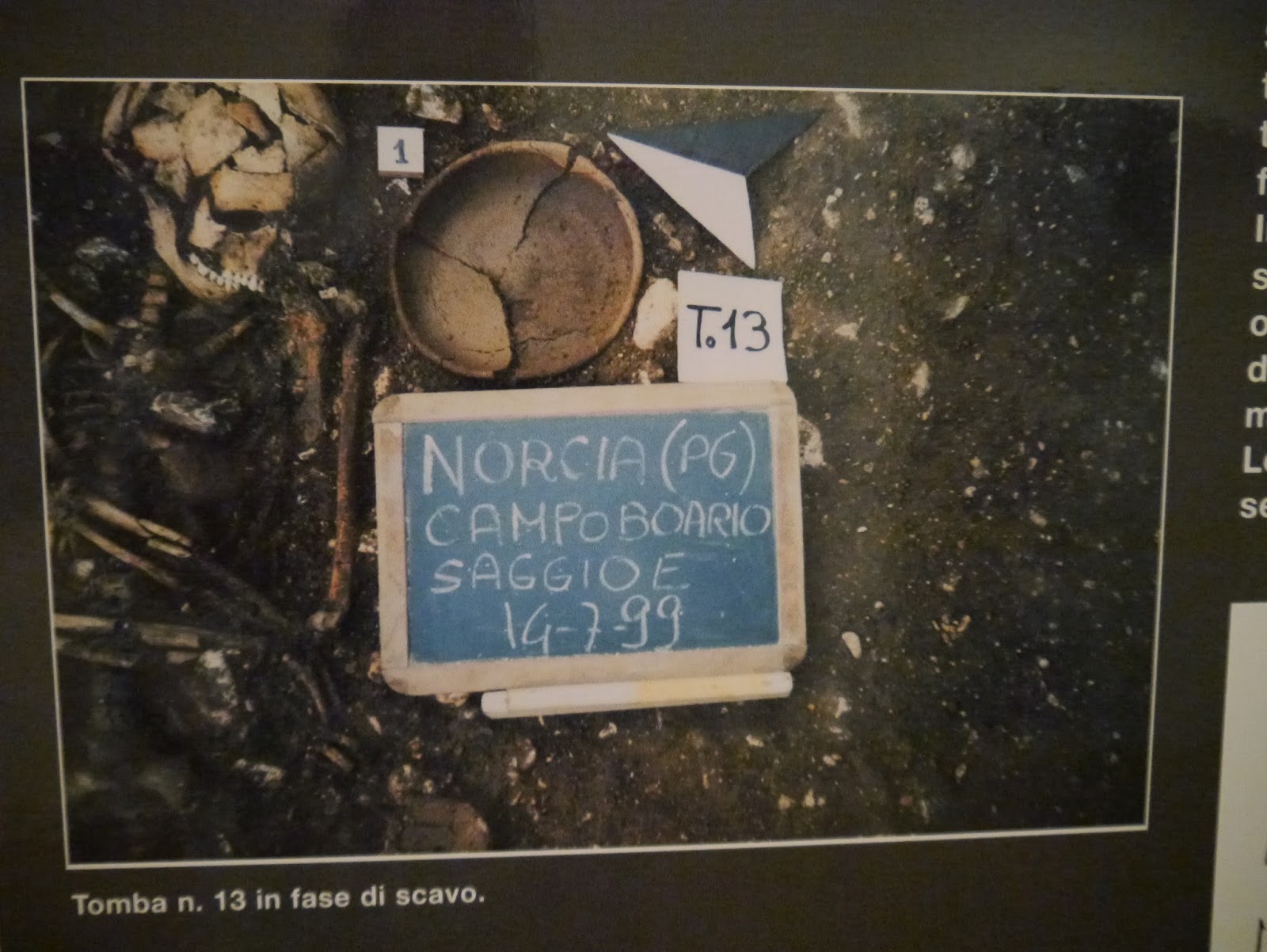 |
| Caves of Orvieto |
There are so many layers under everything in Italy. If you dig a mere metre under the ground anywhere in this country, it’s very likely that you’ll ind some evidence of ‘those who went before’. Rome is known for it’s creepy crypts, and its Roman ruins everywhere. But even in the centre of the country, high in the mountains, there’s lots of history underground.
In Norcia
The Umbrian town of Norcia, in the Sibylline Mountains, was founded by the Sabines, a pre-Roman people. According to historians the area was inhabited right from the Neolithic age but the first records of continuous settlement date back to the 8th century BC. There was also Etruscan influence in Norcia, from the next-door territory that is modern Tuscany.It’s said that the name ‘Norcia’ name came from the Etruscan name ‘Norsia’ (the Etruscan goddess of fortune).
 |
| Finding things under Norcia: grave diggings. |
And then came the Romans. Ancient ‘Nursia’, as it was also known in Latin, was celebrated in the works of Livy, Plutarch and Virgil. It went on record for the first time in 205 BC, when it offered Scipio, in the alliance with Rome, some volunteers during the 2nd Punic War. In the 2nd century BC Norcia was raised to the rank of Prefecture and then to that of Roman Municipality in the fourth region of the Sabine period.
Norcia has fully in-tact walls, surrounded by water meadows (‘marcite’ in Italian) – zones where water, collected and rationally redistributed by a canal system invented by the Benedictine monks in around 400-500 BC, continuously inundates extensive areas of land, thus permitting an abundant hay harvest.
 |
| Luckily there's a guide to explain. |
Near the walls, in a corner of Norcia, there’s an unassuming doorway with a few glass cases inside, displaying some bits and pieces. If you arrive at this little office at the right time, a guide will show you another side of Norcia: recent archaeological diggings under the streets above. You don’t need to walk very far down to find the first of the Roman pavements and column bases. Then you meet a large solid wall, which the guide explains was the wall of a very wide porticoed square -- we’re standing in one corner of the storage areas that surrounded it; you can find another corner across town in a bar.
 |
| Roman walls. |
 |
| Beautiful finds. |
But upstairs, in those glass cases, are some extraordinary finds: pots, bones, coins, even the metal nails from long-decomposed wooden sandals, found in grave diggings near the town. Two wonderful urns with delicate carved decorations were dug up by someone’s brother-in-law, only a foot underground, when he was extending his cellar. These objects date right back to the Sabines and Etruscans - the Etruscan vases are particularly beautiful - up until the Romans.
You know you’ve looked far back in time when the Romans seem recent.
 |
| A beautiful Etruscan bowl. |
In Orvieto
There are a lot of reasons to visit beautiful Orvieto, in Umbria, but who would have thought that underground caves would rank as one of the town's highlights? These caves have existed since Etruscan times, and many are still used today. Each family had its own cave - a kind of cellar - dug into the soft rock of the craggy mesa upon which Orvieto sits. Because the caves don’t interconnect, there are literally thousands of them, keeping those who are interested in such things very busy trying to map them.
 |
| Trying to map the caves of Orvieto. |
Two are fitted with lights and open to guided tours. In one you can feel the cool, even temperatures, see the equipment of a wine press and cellar still in place, and goggle at an Etruscan well: rectangular, with hand and feet holds down the sides, because they were dug by a small Etruscan person wriggling down until the water table was reached.
 |
| Etruscan lessons in well-digging. |
 |
| Pigeon niches, underground Orvieto. |
The second cave is warmer because it has window-openings out of the side of the town’s crag. The caves here were used for storage, and for animals. Fascinating to see the pigeon-coops: caves with a window opening to the sky and small pigeon-sized niches for the homing birds to return to. Apparently pigeons were excellent food animals to keep because they breed incessantly, fly off to feed themselves, and always come home.
One rather sombre cavern in this cave had benches carved into the rock walls - it had been used as a bomb shelter and hospital during the 20th century wars.
The things you find underground in Italy.
 |
| This may look unprepossessing, but...the nails from the wooden sandals of a buried Roman. Norcia. |
No comments:
Post a Comment